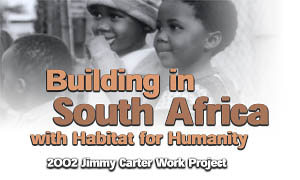
In the construction industry, we make our living furnishing those in need with shelter. Even those of us involved in commercial or industrial construction perform most of our work in support of activities that all boil down to the fulfillment of one of several basic human needs: food, water, clothing and shelter. With our resources and talents, we have the opportunity to share some of our abundance with those who might otherwise not have access to decent shelter. For more than 25 years, the partnership among the construction industry, churches, community groups, corporations, individuals, aspiring homeowners and Habitat for Humanity International has done a remarkable job of helping many to achieve this goal.
One of the highlights of HFHI’s illustrious history has been the Jimmy Carter Work Project, held annually since 1984. JCWP began in 1984 when former President Jimmy Carter and his wife, Rosalynn, traveled to New York City to participate in reconstructing apartments with homeowners and other HFHI volunteers. A resounding success, JCWP became an annual event with building sites all over the United States and numerous other countries across the globe.
JCWP 2002 built 1,000 homes in 18 countries on the continent of Africa, with the main build site in Durban, South Africa. There, the Carters were joined by HFHI founders Millard and Linda Fuller, numerous dignitaries from Africa (including at least one queen and several former heads-of-state), thousands of local volunteers, and more than 1,000 volunteers from the United States and other countries around the world. These forces combined with a very well organized local HFHI affiliate in South Africa to complete construction of 100 single-family dwellings in one week.
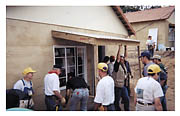
Building “Simple, Decent Homes” in Durban
The Durban build site is located on a hilly, wooded area not far from the center of the city. These first hundred homes are part of a master plan that will add 200 more homes, along with recreational and educational facilities, by 2005. The land is located in an area known as Cato Manor. In the early 1960s, thousands of Indians and black Africans were removed from this area by the government’s apartheid authorities. Their houses were torn down and the land was cleared to reinforce racial separatism and to open the land for white occupation. In all these years, the land has been largely untouched, but is now being pressed into service to help with the enormous housing problem that exists all over Africa.Let the Building Begin
Volunteers assembled on the construction site on a Monday morning in early June, the middle of South Africa’s winter. The winters are temperate in this coastal city and the days are short, so work began each day at the first light and went until dark. On day one, there were a hundred slabs with masonry corners and scaffolding in place. The goal was to raise all four concrete block walls on that very first day. Key to meeting this goal were the pools of mortar, one per every four units, that were brought in by ready-mix trucks. Each home site had 20 to 40 (mostly inexperienced) volunteers, one house leader, several crew leaders, and one professional mason. By the end of the day, nearly all walls were complete with door and window frames set and ready to go.
The homes were all the same size with several configurations. The roughly 600-square-foot dwellings had a living area, two bedrooms, a full bath and a small food preparation room with a sink and small counter top. This type of home is common in many areas of the country, and is prized by those working-class individuals who otherwise live in dense apartments or one of the many shantytowns or shacks that dot the landscape almost everywhere here.
Roofing on Air
From there it was time to get on with the business of roof framing, beginning with a top plate secured to the top row of block, which had been filled with mortar holding metal wind bracing. This framing activity was much more familiar to the Americans on site, as much as they were largely unfamiliar with masonry construction. Wood framing is not as common or inexpensive in South Africa as in the United States. Wood trusses were topped with (2-by-2) purlins spaced to accept the concrete roof tiles.
The concrete tiles were all colored clay red, and were furnished by LaFarge Roofing of South Africa. LaFarge has branch distribution outlets throughout South Africa and sponsored several of the homes on the Durban site. The roof framing was sufficiently pitched to meet the local building code without the use of an underlayment. The framing allowed for a perfect fit of the tiles without the need for cutting or trimming field tiles. The rake starters and apex pieces were all pre-cut and staged. All tiles were laid on the purlins, with only the first two eaves and two rake tiles fastened. All other tiles were lain loose, without fasteners or clips of any kind. The use of “open-space sheathing,” as it is sometimes called, is common in many areas outside of the United States.
From Red to Blue
The ceilings of the homes were insulated with a couple of inches of blue Dow insulation board. Dow Chemical Co. is a major supporter of HFHI, and actually sponsored the construction of 10 homes in Durban. During the week, Kathleen M. Bader, Business Group President for The Dow Chemical Co., Dow Europe, GmbH, announced that Dow had contributed funds for the construction of an additional 10 homes to be built after the JCWP 2002, and an additional contribution to community activities. Not content to simply bring the checkbook, Bader was also among the many volunteers who came to work on the build all week long.Homes of this type in South Africa frequently have corrugated metal or cement/asbestos panel roofing without insulation. Yes, they still manufacture asbestos roofing, siding and other construction products in South Africa. With the epidemic of AIDS and exceedingly high unemployment, issues such as asbestos do not have so much impact here. The combination of the concrete tile roofs and insulation will make these homes much more “livable,” especially during the heat of the day, or in the rainy season.
The block walls were cleaned and coated inside and out with a “Stipple-crete” product that provides a finish color along with some measure of a damp-proofing barrier. This was delivered as a dry mix that was made into a viscous slurry, which was applied by brush. There was no other insulation used on the exterior walls.
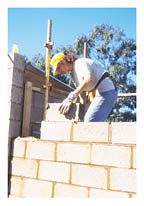
A Newfangled Wall System
The interior walls were constructed of gypsum board over wood framing. The inside of the block walls were not finished with drywall. In South Africa, the interior walls would normally be constructed of concrete block like the exterior walls. South African consumers typically consider drywall “temporary,” such as the walls in commercial office buildings. The nature of a one-week build, however, requires building techniques that can keep up with the pace. BPB Gypsum (PTY) Ltd. South Africa sponsored all the ceilings and drywall for the build. The company is a privately held firm that traces its beginnings back to the original Gypsum Products in 1929. BPB furnished its 15-milimeter “RhinoWall” system for all the interior wood-framed walls, and a rigid ceiling board (1/4 inch thick) that utilized a vinyl “H” divider between the joints. This is the prevalent ceiling system in South Africa, with the upgrade being a 3/8-inch board.Residential usage of drywall systems is still in its infancy in South Africa, and BPB Gypsum took advantage of the publicity to point out the durability of its board, and the speed with which the RhinoWall system could be installed. To counter the impression that drywall is weak or temporary, the RhinoWall boards are particularly rigid, dense and heavy.
The inside walls were finished with a crown mould made of the same 2-by-2 that was used for the roof framing. The shoe moulding was vinyl set in a trowel-grade adhesive. The interior floors sported a natural concrete finish ready for throw rugs or other homeowner-furnished upgrades.
The gable ends of the block homes were finished with an RB&B transite siding board that received a few coats of paint. The front porch (and roof over the bath and food preparation area on some models) was topped with corrugated transite panels. The installation of the front porch awnings proved challenging on many of the homes, and on Thursday President Carter took note of this. His house being on or ahead of schedule, President Carter took some of the people from the house he was working on along with the necessary tools, and went around the building site installing the porch awning on over half the homes.
The most challenging point during the week came Thursday when it appeared that many of the homes were behind schedule finishing the drywall. The house leaders got together and decided to stay late and work house-to-house to get the job done. By mid-morning Friday the schedule was righted. The painting and finishing proceeded only two hours beyond the original scheduled finish time and allowed for dedicating the homes complete with trees planted in the yard before dark. At dark, the volunteers were treated to a victory celebration with speeches and music and dancing and a genuine South African Braai (barbecue).
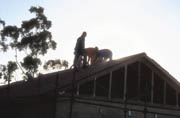
On a Personal Note
It was a great honor to work on the JCWP 2002 in Durban, tagging along with a band of 18 others from Georgia, Florida, and Washington, D.C. (Mark and Lael Butler’s gang). While the work was physically challenging, much was learned about different construction methods and several different cultures. It was especially gratifying to work side-by-side with homeowners, Bheki and Nondumiso Nxumalo. It took the entire week to learn how to pronounce their beautiful last name with a “click” where the “x” is. Zulu is a beautiful language to hear, even without understanding a word of it. Luckily, the Nxumalo’s English is excellent. They, like all the other South Africans, are warm and welcoming people.South Africa still faces a myriad of political and social challenges. JCWP 2002 did much to show what people can do when they work together. Led by Mayor Obed Mlaba, the government in Durban, like HFHI, is committed to ending poverty housing. Mayor Mlaba has committed himself and his administration to take this culture of volunteerism and cooperation and, within 10 to 15 years, make the tremendous lack of affordable housing “a thing of the past.”
To that end, this hillside in Cato Manor, where greed and hatred came to destroy hope 40 years ago, has now been renamed Ethembeni, Place of Hope. For 100 South African families, JCWP 2002 represents a significant dream fulfilled. For people across the continent of Africa, this event will mark a renewal of faith in their fellow man, and each other.
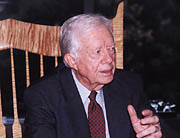
Perspective: Jimmy Carter
In an interview some months after the conclusion of the JCWP 2002, former president Jimmy Carter was asked about his choice of Durban, South Africa, for the build, and he responded, “I thought it was an excellent choice. It was the first time we have had the Jimmy Carter Work Project in Africa. And we were torn … between Uganda and South Africa. But I think it worked out well because of the site chosen; the fact that it had a history of … the ravages of apartheid. When all the previous occupants of that beautiful hillside were forced out ... and now to see them come back home was a very fine political and social event, and I thought quite significant.”As to the logistics and construction, Carter says, “The build itself was beautifully organized; the sites were well prepared.” On all Jimmy Carter Work Projects, Carter insists on having building plans submitted to him in advance to be sure they fit the model of simplicity and adequacy. He made several suggestions to the designers on this build based on his experience with building with volunteers and in narrow windows of time. One was the change from all the buildings having six corners to having a mixture of more simple, four-cornered designs. This proved quite valuable given the tight schedule that called for all exterior walls to be constructed in the first day. About another suggestion, Carter says, “They were going to have a 12:12 roof at the beginning, which is very difficult for volunteers … so because of my request … they simplified the buildings and reduced the slope of the roof.”
Of the volunteers and contributors, Carter says, “I thought the enthusiasm of the workers was excellent … the generosity of the private sector was excellent. Contributions of materials; the mortar mix, the block, the roofing materials, the paint … was all very generous.” He continues, “We had a good balance between international volunteers and those from South Africa. It’s very good to have a demonstration that volunteerism can be a permanent and beneficial and enjoyable event.”
The Carters’ grandson, Jason, was in Durban as a volunteer working on the site. The proud grandfather cites Jason’s ability to speak fluent Zulu as the bright spot of the event. President Carter says, “He was in the Peace Corps in South Africa for almost two and a half years and he became fluent in Zulu.”
President Carter continues to set the pace for all former heads-of-state with his work as a volunteer, humanitarian and elder statesman.
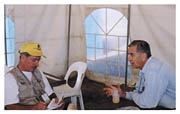
Perspective: Millard Fuller
JCWP 2002 may be the first Jimmy Carter Work Project ever held in Africa, but Habitat for Humanity can trace its roots back here. Millard Fuller and his wife Linda came to Africa with their four children in 1973 to build houses in partnership with the people of Zaire. In 1976 they returned home and founded Habitat for Humanity International.At the JCWP 2002 build site, Millard Fuller was asked how Africa has changed since the early 1970s. He likened Africa at that time to Alabama in the 1940s. Fuller grew up in Lanett, Ala., where there was rigid segregation of the races: separate beaches, buses, neighborhoods, etc. Today, crime is a big problem in South Africa. Many South Africans suffer from a low standard of living, high unemployment, and an epidemic of AIDS, but Fuller says, “Still, it is now a much freer society, which creates opportunities such as this build. This build will move us to the next level.”
Fuller is passionate about the work of Habitat for Humanity. He sincerely believes that every single human being on this planet is entitled to a simple, decent place to live, and that it is within our power to make that happen. He says, “Life doesn’t have to continue as it is, we can make it better. This creates a new way of thinking. There is no shortage of money, just a willingness to solve the problem.”
As for the partnership between HFHI and the roofing and construction industry, Fuller cites participation of key suppliers such as CertainTeed and Dow, and builders such as John Wieland and Centex. Speaking directly to the roofing industry, he says, “The roof is the most important part of the house. You are protecting humanity from the elements. From Habitat for Humanity’s standpoint, we would find it difficult to operate without the support of the roofing industry.”
Fuller and his wife Linda have devoted their lives to the mission of ending poverty housing in the world. Habitat for Humanity has built more than 100,000 homes worldwide in its first 25 years, and has a goal for its next 5 years: build another 100,000.
Habitat for Humanity International
- HFHI is a non-profit, ecumenical Christian housing ministry.
- HFHI seeks to eliminate substandard housing and homelessness from the world and to make decent shelter a matter of conscience and action.
- HFHI has built more than 100,000 houses around the world in its first 25 years, providing more than a half a million people with safe, decent, affordable shelter.
- Through volunteer labor and donations of money and materials, Habitat builds and rehabilitates simple, decent houses with the help of homeowner (partner) families.
- Habitat houses are sold to partner families at no profit, financed with affordable, no-interest loans.
- The homeowner’s monthly mortgage payments are used to build still more Habitat homes.
- HFHI’s work is accomplished at the community level by affiliates, which are independent, locally run, nonprofit organizations.
- There are more than 1,900 active affiliates in over 80 countries; 1,600 are in the United States.
- Partner families are selected based on level of need, willingness to participate in the program and ability to repay the no-interest loan.
- Neither race nor religion is a factor in choosing partner families.
- Habitat is not a governmental agency and does not accept government funds for construction of houses, but does work with government agencies toward fulfilling its mission of eliminating poverty housing.
- HFHI is managed by an ecumenical, international board of directors.
Report Abusive Comment